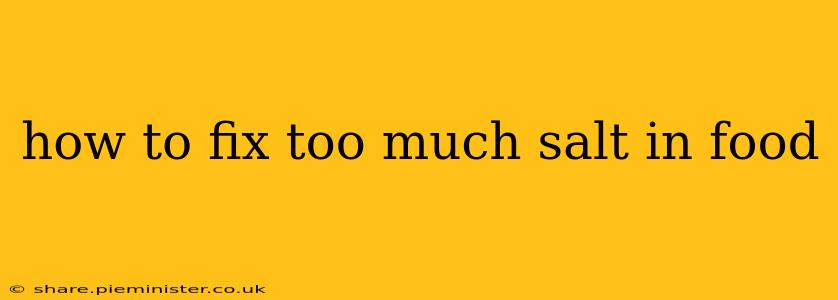Adding too much salt to a dish is a common cooking mishap, leaving you with a meal that's unpleasantly salty and potentially inedible. But don't despair! There are several ways to salvage your culinary creation and restore a balanced flavor profile. This guide explores effective methods to reduce the saltiness of your food, helping you avoid throwing away perfectly good ingredients.
Why Does Adding Too Much Salt Happen?
Before diving into solutions, it's helpful to understand why over-salting occurs. Often, it's simply a matter of accidentally adding too much salt during the cooking process. Other contributing factors include:
- Using a heavy hand: Many cooks instinctively reach for the salt shaker without measuring, leading to unintentional excess.
- Pre-salted ingredients: Cured meats, canned goods, and pre-packaged sauces often contain significant amounts of sodium, which can easily be overlooked.
- Salty ingredients: Certain ingredients, like olives, anchovies, and soy sauce, are naturally high in salt and require careful consideration when incorporated into a recipe.
- Poorly calibrated salt shaker: A clogged or over-filling salt shaker might release more salt than intended.
How to Fix Too Much Salt in Food: Practical Solutions
Depending on the dish and the stage of cooking, different techniques prove effective at reducing saltiness.
1. Adding More Ingredients: Dilution is Key
The simplest method involves adding more ingredients to dilute the salt concentration. This approach works best for soups, stews, and sauces:
- Liquids: Adding water, broth, or stock can help to reduce the overall saltiness. Start with small amounts and taste as you go.
- Vegetables: Incorporating additional unsalted vegetables such as potatoes, carrots, or zucchini can absorb some of the excess salt. Choose vegetables that pair well with the dish's flavor profile.
- Acids: A splash of lemon juice, lime juice, or vinegar can help balance the saltiness and add a refreshing counterpoint. The acidity cuts through the saltiness and brightens the overall taste.
- Starchy ingredients: Adding unsalted rice or potatoes can absorb the excess salt. This works particularly well for soups and stews.
2. Adding Sweetness to Counteract Saltiness
Sweetness is a natural counterpoint to saltiness. Adding a touch of sugar or a sweet ingredient can help balance the flavors:
- Sugar: A small amount of sugar, added sparingly, can neutralize the saltiness. Be careful not to overdo it, as this can lead to an overly sweet dish.
- Honey or Maple Syrup: For a more sophisticated approach, consider adding a touch of honey or maple syrup. These add a subtle sweetness and complexity.
Important Note: This method works best for savory dishes where a hint of sweetness complements the existing flavors. Avoid this technique if sweetness is not a natural component of the dish.
3. Adjusting the Cooking Method
For some dishes, adjusting the cooking method can help alleviate excessive salt.
- Simmering: Allowing a dish to simmer for a longer period allows the flavors to meld and the salt to distribute more evenly.
- Adding Salt Late: Next time, remember the best practice is to add salt towards the end of cooking to ensure optimal flavor balance.
4. Serving with Accompaniments
If all else fails, consider serving the dish with accompaniments that contrast the saltiness:
- Bread: Plain bread or rice can absorb some of the excess salt.
- Unsalted Side Dishes: Serving with unsalted vegetables, rice, or salad can balance the overall meal's saltiness.
What If It's Still Too Salty?
If, after trying these methods, the dish remains too salty, it may be best to discard it. However, before doing so, you might experiment with more extreme measures:
- Dilution: You could consider adding an exceptionally large amount of liquid to dilute, potentially turning it into a much less concentrated version, though this may significantly alter the texture and consistency.
Frequently Asked Questions (FAQ)
Can I remove salt from food?
Unfortunately, there's no foolproof method to completely remove salt once it's been added to a dish. The techniques mentioned above focus on reducing the perceived saltiness, rather than eliminating it entirely.
How can I avoid over-salting in the future?
- Measure your salt: Use measuring spoons or a scale for accurate salt addition.
- Taste as you go: Regularly taste your food during the cooking process to monitor the salt level.
- Start with less salt: It's easier to add more salt than to remove it. Begin with a small amount and gradually increase if necessary.
- Consider the sodium content of your ingredients: Check food labels and be mindful of pre-salted ingredients.
- Use a good quality salt: Fine sea salt can be easier to control than coarse salt.
By following these tips, you can avoid over-salting and consistently create delicious and well-balanced meals. Remember, practice makes perfect; don't be discouraged by occasional mishaps!
